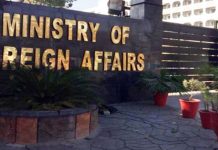——- Witnesses firing of air defence systems in Al-Bayza-III exercise
——- Expresses satisfaction over the combat readiness of troops
——- Also inaugurates second chapter of NASTP in Karachi
——- Feels optimism about project’s potential to propel technological progress
By Asghar Ali Mubarak
RAWALPINDI: In a display of precision and strategic prowess, General Syed Asim Munir, the Chief of Army Staff (COAS), observed the firing of various Air Defence weapon systems during Exercise Al-Bayza-III, 2024, in Sonmiani on Friday.
The exercise showcased the integrated fire and battle maneuvers of Army Air Defence systems, mark-ing a landmark achievement in bolstering the Air Defence capabilities of Pakistan’s aerial frontiers, the Inter-Services Public Relations (ISPR) said in a statement.
The COAS witnessed the live demonstration of High to Medium Air Defence Weapons System (HI-MADS), Low to Medium Air Defence System (LOMAD), Short Range Air Defence System (SHORADs), and Extended Short Range Air Defence System (ESHORADs). Notably, the HIMAD system achieved a significant milestone by successfully engaging targets at maximum ranges, showcasing its efficacy in the nation’s defence strategy.
Expressing his appreciation for the remarkable achievement, General Munir commended the precision with which targets were engaged and the operational readiness displayed by the Corps of Army Air Defence.
The successful integration of layered weapon systems demonstrated the military’s commitment to staying at the forefront of technological advancements in national security.
During interactions with officers and troops, the COAS highlighted the ongoing modernisation efforts within the armed forces. He pointed out that these enhancements are tailored to meet the specific requirements of Pakistan, aiming to deter potential threats and ensure a robust response to any chal-lenges that may arise. The exercise was attended by Corps Commander Karachi, Commander Army Air Defence, Inspector General Training & Evaluation, and Inspector General Arms, all of whom wit-nessed the strategic ma-neuvers firsthand.
Their presence underscored the collective commitment to maintaining the highest standards of pre-paredness and excellence within the armed forces.
Before the exercise, Gen Munir visited the Army Air Defence Center, where he paid homage to the martyrs of the Armed Forces by laying a floral wreath at Yadgar-e-Shuhada (martyrs monument). As a symbol of recognition for outstanding leadership, he installed Lieutenant General Muhammad Zafar Iqbal, HI (M), as the Colonel Commandant of the Army Air Defence Corps.
Earlier, General Syed Asim Munir, the Chief of Army Staff (COAS), graced the inauguration ceremony of the second chapter of the National Aerospace Science and Technology Park (NASTP) Silicon, held in Karachi on Friday.
As the chief guest at the occasion, General Munir expressed his optimism about the project’s potential to propel technological progress and cultivate self-reliance in the nation, the Inter-Services Public Rela-tions (ISPR) said in a statement.
COAS Munir hailed NASTP as a project of national and strategic significance that is poised to bring about manifold benefits for the country. He highlighted the crucial role it would play in fostering inno-vation and providing a platform for the nation’s youth and future generations to contribute to the fields of aerospace, cyber, and information technology.
Praising the collaborative efforts of the Pakistan Air Force (PAF), its leadership, and skilled personnel, Gen Munir celebrated the achievement of yet another milestone in the form of NASTP Silicon. He acknowledged the pivotal role played by the PAF in making the project a reality and lauded their com-mitment to technological advancements.
Chief of Air Staff, Air Chief Marshal Zaheer Ahmed Baber Sidhu, also shared his vision for NASTP to evolve into one of the best Aerospace, Cyber, and IT Clusters. He envisions the park transforming the national landscape with state-of-the-art design, research and development (R&D), and innovation centers, focusing on emerging and disruptive technologies. The goal is to maximize social, economic, security, and scientific dividends for the country.
Upon his arrival at the venue, the army chief was warmly received by Air Chief Marshal Sidhu. The co-operation and synergy between the army and air force leadership were evident, reflecting a united commitment to the advancement of the nation’s technological capabilities.
Following the inauguration ceremony, Gen Munir visited the Corps Headquarters Karachi. The Corps Commander Karachi Corps welcomed the Chief of Army Staff and provided a comprehensive briefing on operational preparedness, training initiatives, and administrative measures undertaken for the wel-fare of troops and the families of Shuhada (martyrs).
The visit underscored the holistic approach of the military leadership in addressing not only technologi-cal advancements but also the well-being and preparedness of the armed forces. The COAS expressed satisfaction with the measures taken and reiterated the importance of a strong, well-equipped, and well-supported military in safeguarding the nation’s interests.




